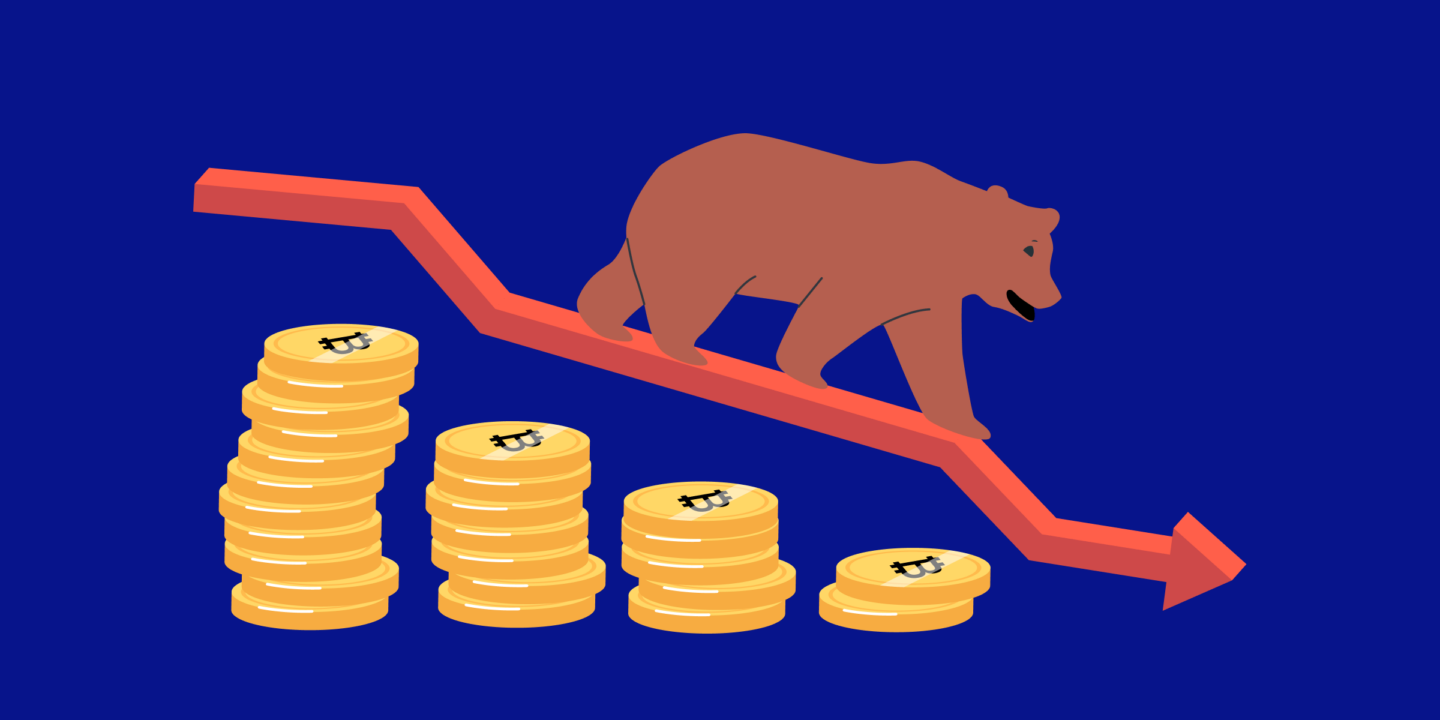
In crypto markets, there is a saying: “bulls make money; bears make money too.” Since most of the market wishes for a bull run, many traders and investors feel discouraged when prices fall. It’s easy to get caught up in the doom and gloom of lower prices, but there are still some ways you can generate returns on your investments in a crypto bear market. Read on to know how!
What Is A Crypto Bear Market?
In general terms, a bear market describes a prolonged period of decline in the overall market prices. In a crypto bear market, the prices of major currencies will continue to decline for an uncertain period.
A bear market isn’t necessarily triggered by any specific event. Instead, it is usually caused by numerous negative factors within the market, including high inflation and uncertainty about the future prices of the coin or token.
This decline in prices often affects all major cryptocurrencies, leaving many traders wondering if they should continue to HODL or cut their losses and sell. We will discuss how you can generate returns during this bear market throughout this article.
A disclaimer before we begin: it’s important to remember that bear markets are unpredictable by nature, so there is no guarantee that any strategy presented in this post will be successful for everyone. If you use these strategies, do so at your own risk. With that being said, let’s get started!
What Should an Investor Do in a Cryptocurrency Bear Market?
1. Make the right buys
When a bear market begins, it is often difficult to determine which cryptocurrencies will emerge as winners. Even more so, it’s almost impossible to predict which cryptocurrencies will decline the most.
It is often recommended that investors make small investments in a range of different coins and tokens throughout bear markets. This allows you to capitalize on smaller price movements that could lead to substantial returns if they continue or consolidate into more significant trends later.
2. Diversify your portfolio
The crypto market is extremely volatile, and investing in just a few cryptocurrencies can be risky because these projects often go through dramatic ups and downs, sometimes without any apparent reason at all. Diversifying your portfolio reduces this risk by distributing your capital among multiple tokens across various sectors.
This process helps reduce your exposure to the volatility of individual coins or tokens while increasing your chances for solid returns. In the long run, diversifying your portfolio can often generate better returns than just investing in a few coins or tokens that you believe will take off.
3. Keep up with news and updates
In a bear market, it can be easy to get wrapped up in price movements and lose sight of everything else going on within the industry. It’s important not to underestimate the power of FUD (fear, uncertainty, and doubt) when prices are low because this can lead to panic selling at the wrong time. To avoid this scenario, make sure you keep up with news and updates surrounding top projects within the cryptocurrency space. This will help explain why prices are declining while also giving insights into which projects have maintained momentum despite the bear market.
4. Be patient during price declines
This is probably the most essential trait to showcase in a bear market. When prices are declining, your first instinct might be to sell immediately in an attempt to minimize losses. But if you do so without waiting for signs of a rebound, you could end up selling at a low point, which will result in more significant losses than if you had waited it out.
By patiently holding onto your investments, even after price declines occur, you can often take advantage of rebounds that usually follow significant drops. If these opportunities continue into strong uptrends, this can help generate substantial returns for your trading portfolio. Although cryptocurrencies are volatile by nature, and there’s no guarantee that any strategy presented here will be successful or profitable for anyone, these strategies can still be beneficial for those looking to generate returns during bear markets.
Signs and Indicators of a Crypto Bear Market
One important fundament of the cryptocurrency market is that it is primarily driven by sentiment. However, there are also some other indicators of a bear crypto market:
1. Exchange inflows
An indicator of negative sentiment in the crypto market is ‘selling.’ Therefore, any intention to sell is a powerful indicator of pessimism around price. If sellers are piling up sell orders, it means that they’re ready to sell the cryptocurrency in question at any price. This can be seen as a sign that the bear market is around the corner since the sell orders are just waiting for buyers to pass their thresholds.
2. Changes in dormant addresses
Stanley Druckenmiller, a legendary crypto investor, had once said, “Do you know that when Bitcoin went from $17,000 to $3000, 86% of the people that owned it at $17,000 never sold it?”
This is because a dormant address is one where the balance has remained unspent for a significant amount of time, and most people actually believe that crypto has long-term potential. So essentially, they do this: when prices are low, they buy more cryptocurrency, and when prices are high, they sell small portions of their holdings to minimize their losses. All of which can ultimately bring about a change in sentiment.
3. Miner/treasury outflows
Miner and treasury outflows are also indicative of a bear market. Miners who are in business need to sell their mined cryptos for fiat, which is where the treasury comes in. So naturally, the more a miner or treasury is selling cryptos for fiat, the more likely there’s a bear market going on.
4. Futures and funding rates
The futures market and interest rates are also indicative of a bear market. The funding rate is the cost that cryptocurrency exchanges borrow money to trade. So naturally, if exchanges borrow money at high rates, it means there’s not much demand for loans. Futures markets are where cryptos can be traded on margin by investors who do not hold any cryptos but wants to benefit from its price movement. If futures markets are active, this implies more buyers than sellers or vice versa, which ultimately helps determine whether there’s a bull or bear crypto market.
The Bottom Line
The bear market in the cryptocurrency industry is a challenging time for many traders. However, there are still ways to generate returns during this period with patience and careful strategy. To do so, you should look out for signs of a bear crypto market, such as an influx of selling activity or changes in dormant addresses that have been inactive for significant periods. If these indicators appear at once or together, a downturn in prices will likely follow soon after, which could present investors with opportunities to buy more cryptocurrency cheaply before they rebound again into uptrends.
One crucial fundamental about the crypto markets is how sentiment-driven they can be; therefore, recognizing when pessimism comes around can help you make decisions like trading on margin (buying cryptos on margin), which can help you generate returns even if the price of cryptos continues to go down.





